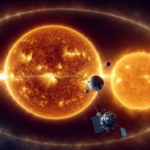An In-depth Look at New Glenn and Ariane 64’s Capabilities
Exploring the frontiers of space exploration necessitates the development of advanced rocketry technology. Two notable players in this domain are New Glenn, developed by Blue Origin, and Ariane 64, heralded by the European Space Agency (ESA). Both rockets signify remarkable engineering feats, poised to expand humanity’s reach beyond the confines of Earth. Their capabilities, though varied, offer intriguing insights into the future of space travel and satellite deployment.
New Glenn stands as a testament to reusable rocket technology, aiming to reduce the costs associated with space exploration. Its design includes a reusable first stage, capable of landing back on Earth for subsequent missions. This behemoth boasts the ability to carry up to 45 metric tons to low Earth orbit (LEO) and 13 metric tons to geostationary transfer orbit (GTO), showcasing its versatility in deploying a wide range of payloads. Moreover, the New Glenn’s 7-meter fairing provides ample space for large satellites and interplanetary spacecraft, underlining its role in future deep space missions.
On the other hand, Ariane 64 is designed with precision and heavy-lift capabilities in mind. Engineered to transport over 10 metric tons to GTO and an impressive 20 metric tons to LEO, it caters to both commercial and governmental payload needs. Its configuration with four solid rocket boosters enables it to offer one of the most reliable and powerful launches available today. Furthermore, Ariane 64’s design emphasizes flexibility, allowing it to carry multiple satellites in a single mission, thus optimizing space utilization and reducing costs for satellite operators.
The exploration capacities of New Glenn and Ariane 64 illuminate the pathway to not only commercializing space travel but also in enhancing our understanding of the universe. As these rockets prepare for upcoming missions, their roles in deploying satellites, research probes, and even manned missions to orbit provide a promising glimpse into the next era of space exploration. With each launch, New Glenn and Ariane 64 are not just reaching for the stars but are also crafting the foundation for an interconnected and space-faring civilization.
Comparative Analysis: New Glenn vs. Ariane 64
When it comes to comparing the capabilities and specifications of space launch vehicles, the New Glenn and the Ariane 64 emerge as noteworthy contenders. Each has distinct features, intended missions, and technological advancements that signify their roles in the future of space exploration and satellite deployment. The New Glenn, developed by Blue Origin, and the Ariane 64, by ArianeGroup, showcase the evolving landscape of aerospace technology and the strategic priorities of their developers.
New Glenn, named in honor of John Glenn, is designed as a heavy-lift launch vehicle capable of putting over 45,000 kilograms into Low Earth Orbit (LEO). Its design focuses on reusability, with a first stage intended to be flown 25 times. This emphasis on reusability seeks to reduce the cost of access to space, a core mission for Blue Origin. Equipped with seven BE-4 engines, the first stage of New Glenn boasts significant thrust capabilities, highlighting its design for versatility in launching commercial satellites, interplanetary missions, and supporting the Blue Origin vision of millions of people living and working in space.
In contrast, Ariane 64 is built by the ArianeGroup, a stalwart in the global launch industry, and is the more powerful version in the Ariane 6 family, capable of lifting approximately 21,000 kilograms to Geostationary Transfer Orbit (GTO). With its configuration of four solid rocket boosters coupled with a liquid-fueled core, Ariane 64 is optimized for dual launches, capable of delivering two heavy satellites into orbit in a single mission. This reflects the ArianeGroup’s strategy to offer competitive pricing and flexibility for satellite operators aiming for GTO and beyond.
Both New Glenn and Ariane 64 incorporate innovations aimed at reducing mission costs and expanding mission profiles. However, their operational philosophies and target markets do indeed diverge. The New Glenn’s focus on reusability aligns with newer space industry trends, whereas the Ariane 64, while incorporating elements of innovation, remains somewhat more traditional in its approach to launch services. Regardless, both vehicles are critical to their operators’ future success and the overall evolution of space logistics and infrastructure.
Future Prospects: Revolutionizing Space Launch
The realm of space exploration is on the cusp of a significant transformation, particularly in how we launch into outer space. With advancements in technology and a growing interest from the private sector, the future of space launch looks promising, aiming to make space more accessible, sustainable, and cost-effective. One of the pivotal shifts we are witnessing is the development of reusable rocket technology. This innovation is set to drastically reduce the costs associated with space travel by allowing for the recovery and reuse of launch vehicle components, which have traditionally been a write-off after a single use.
Another revolutionary aspect in the sphere of space launches is the exploration of alternative propulsion systems. Scientists and engineers around the globe are delving into possibilities that could one day replace traditional chemical rockets. Technologies like electromagnetic propulsion and even nuclear thermal propulsion are in various stages of research and development. These systems promise not only to make space launches more efficient but also significantly faster, opening the door to deeper space exploration and possibly interstellar travel.
Moreover, the concept of spaceports around the world is gaining traction. Imagine a future where launching into orbit is as routine as catching an international flight. Countries and private entities are investing in the infrastructure to make this a reality, with plans for spaceports in strategic locations across the globe. This would facilitate a higher frequency of launches, support international space cooperation, and lay the groundwork for a global space economy.
The integration of artificial intelligence and machine learning into space launch operations is also anticipated to bring about profound changes. These technologies can optimize flight paths in real-time, predict and mitigate potential issues before they arise, and improve the safety and reliability of space missions. The automation of certain aspects of the launch process could further reduce costs and human error, making space exploration more attainable for a wider range of participants.
Array










